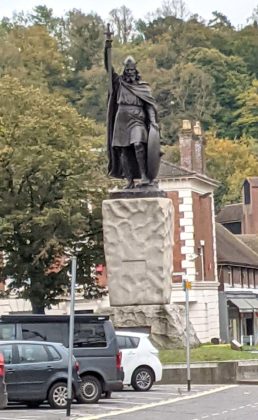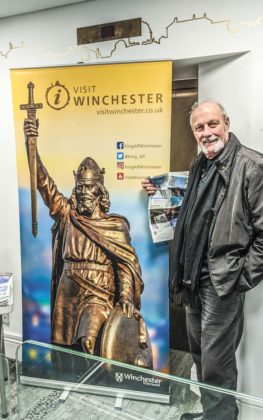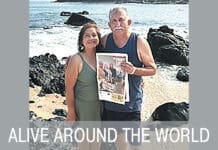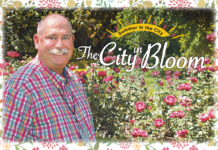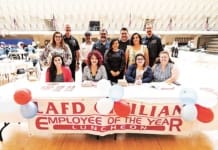 Send in your ALIVE! AROUND THE WORLD
Send in your ALIVE! AROUND THE WORLD
Take Alive! with you wherever you go! Bring your recent copy of Alive! with you when you travel and snap a high resolution photo of you holding Alive! Send in your pictures and text, and we’ll publish it.
SUBMIT YOUR ALIVE! AROUND THE WORLD
![]()
Hawaii
John Burnes, Alive! editor, and Dearbhla McNulty spent the holidays in Hawaii, safely. Aloha!.
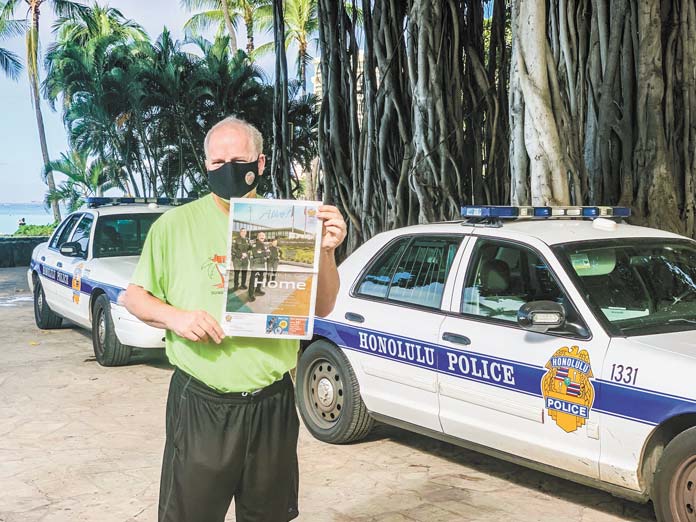
Letter From England, Pt. 4
Capt. Michael Barnes, Retired, Harbor, traveled to the land of his birth, England, post-vaccination.
The Ancient. Friendly Town of Winchester

If you are visiting England for the first time or passing through London’s Heathrow Airport to catch a cruise ship from Southampton, the lovely picturesque city of Winchester might be a perfect destination. I suggest you get to Terminal 2 and catch the National Express coach for a one-hour ride along the M3 motorway to central Winchester. After a long flight, the last thing travelers want is to struggle with your luggage on the Underground or hire an overpriced car rental driving through traffic on the “wrong” side of the road. Coach tickets can be bought in advance online, and my advice is to always pay the small extra fee in case your flight is delayed.
Winchester is a city, but it feels more like a bustling market town. Apart from great historical interest, Winchester has been voted as the top place to live in England. This accolade is due in large part to the friendly ambience and low crime rate. It is a city geared up for tourism with a broad range of accommodations — Mercure Winchester Wessex Hotel, centrally located in the high street area, offers cathedral views and an assortment of coffee shops where we enjoyed tasty cakes and a quick caffeine and sugar boost (!) while we sat listening to street buskers.
The Old Vine pub stands at the end of the Square near a tree-lined path leading to the cathedral entrance. Many restaurants are offering patrons alfresco dining. We enjoyed something different when we tried the Stable Pizza, which specializes in unusual pizzas, and a pint (or two) of real Somerset Cider. After our lunch we took some time to wander around Great Minster Street and the Square. We came upon the 24 bollards that are painted in the style of famous artists, like Henri Matisse, Piet Mondrian and Jackson Pollock.
Entering Winchester by coach at the eastern end of the Broadway you’re met with a striking statue of King Alfred the Great standing in the center of the road facing toward the center. The coach stops adjacent to the statue; from there it is a two-minute walk to the impressive Gothic Revival-styled Guildhall and Tourist Information Office beside the beautiful Abbey Gardens’ well-tended flower borders alongside the river.
When the Romans invaded Britain under Caesar in AD 43, they made Winchester their capital city named Venta Belgarum. Later the invading Saxons called the Roman settlement Venta Caester or Marketplace of the Belgae, which then became Wintancaester, followed by today’s name for the city, Winchester.
Four hundred years later in AD 407, with the Roman Empire crumbling, the last Roman legions were withdrawn from Britain and the country fell into a dark age. Hosts of invaders and settlers followed, including Germanic migrants, the Jutes from the Jutland peninsula (modern-day Denmark), the Angles from Angeln in southwest Jutland and the Saxons from northwest Germany. These tribes formed their own small kingdoms; most of these kingdoms survive to this day and are better known as the English counties Kent (Jutes), East Anglia (east Angles), Sussex (south Saxons), Middlesex (middle Saxons) and Wessex (west Saxons).
King Cenwalh of Wessex built the first church in Winchester, which became a cathedral in 660. St. Swithun is buried outside the cathedral upon his request, and legend has it that when an attempt to move his body was made, it began to rain and continued to rain for 40 days and nights, giving rise to the saying:
St Swithn’s day, if thou be fair, St Swithn’s Day, if thou bring rain. For forty days it will remain.
St. Swithn’s remains were eventually moved 100 years later, with no reports of rain! However local people still believe that if it rains on St Swithin’s day, then it will continue to do so for 40 days.
Winchester was attacked and plundered regularly by the Vikings until the 9th century, when King Alfred removed the old Roman street plan and designed a new one. The new plan was easier to defend and would protect the city’s prosperous wool trade.
During the Norman Conquest (1066), William the Conqueror ordered the old cathedral be pulled down to make room for a new one farther south. Many of the old Saxon kings’ tombs were moved into the new cathedral. Over the centuries, the cathedral has grown into one of the largest Gothic cathedrals in Europe (the impressive Duomo di Milano in Italy is the largest), but it does have the longest nave (the central part of the cathedral) or the longest overall length.
Among the cathedral’s most famous occupants are Jane Austen; Edmund Ironside; Cnut the Great, King of England, Denmark and Norway; and King William Rufus.
Next to the cathedral sits the oldest continuously running school in Britain, originally built to educate poor scholars in 1382, and where today you will find The Pilgrims’ School, a private boarding school. Many successful and famous people have studied there, including Britain’s current Chancellor of the Exchequer, Rishi Sunak, whom some believe will be the next Prime Minister. The school has one of the earliest hammer-beamed buildings known as Pilgrim’s Hall, which is still used by the school’s Senior Commoners for choir rehearsals. Near to the school and a short walk from the cathedral is the historic and cozy Wickham Arms pub, where you can have a drink whilst sitting on the old wooden Pilgrims School desks whilst looking at the amazing number of historical objects dotted all over the walls.
In nearby Great Hall of Winchester Castle hangs a replica of the legendary King Arthur’s round table, built in the 13th century and later painted on the order of King Henry VIII while taking a rest between wives. King Henry had the names of Arthur’s knights added to the table along with a Tudor rose in the middle as a nifty piece of propaganda.
Other places of interest to visit are the City Museum on the corner of Great Minster Street; the High Street’s Buttercross stone statue with its many steps and intricate figures; and the city’s Water Mill, to the north of the city. The mill has been newly restored and is driven by the River Itchen that runs through the city and it is still milling corn by waterpower today.
Twice a month on Saturday there is a large farmer’s market, with more than 100 stalls mostly specializing in local food, plants, and wares. In July, Winchester hosts the annual Hat Fair, the UK’s longest running festival for street artists and entertainers. The final day of the fair wraps up with a huge picnic at the city’s North Walls recreation ground.
Walking around the city’s narrow cobblestone side streets with their dark gothic architecture, or standing outside some of England’s oldest pubs at night, it isn’t difficult to imagine the way people lived between fear, famine, war and the Black Death all those years ago.
Back to the present and on a lighter note, Academy Award winning actor Colin Firth is from Winchester and was educated at Montgomery of Alamein School (now Kings’ School). The Bangkok Bistro, a restaurant he regularly visits, offers The Colin Firth Curry on its menu.
For more local news, myths, and legends, take a seat at the bar in Alfie’s pub opposite the Guildhall. Between pulling pints for thirsty customers, the bartender entertained us with the humorous story of King Alfred’s sword on the statue outside the pub. According to legend, if a female virgin of at least 16 years walks around the statue three times in a clockwise direction, King Alfred will lower his upraised sword. Well considering that the large statue stands in the middle of a traffic roundabout, this alone makes it a difficult and dangerous act to perform. There may have been a little tongue in cheek to this story as the bartender was Irish!
Tip: There is a direct National express coach and train service to Southampton, with easy access to one of the four cruise ship terminals in Southampton, or direct to Victoria Bus and London’s Waterloo train station.
Stop procrastinating; travel while you still can.
Cheers!


